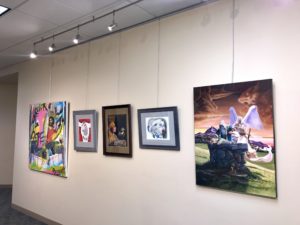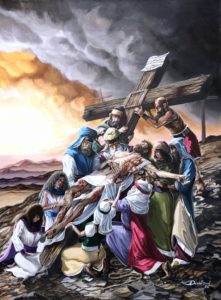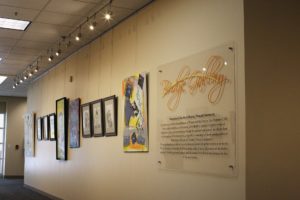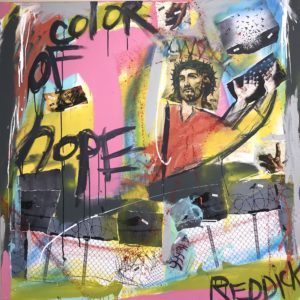Artistic Ministry in the Federal Prison System

Explore Redemptive Art and the Hope that Resides in Inmates

What role does art and creativity have at a place like Supermax federal prison? Justin Reddick, an artist and current MDiv student at Denver Seminary, provides an inspiring introduction to the Creative Arts Platform (CAP), a program he helped bring to the federal facilities in 2016. Justin founded CAP to expose inmates to a variety of different artistic methods, ideologies, and entrepreneur techniques that can help to prepare them for re-entry into public life. For those not releasing back into society, CAP offers a holistic approach to skills development and artistic exploration. This transformative work reaches into their potential as creators and recognizes their humanity as a catalyst for positive change.
Denver Seminary, in conjunction with the Federal Bureau of Prisons, CAP, and seminarian-turned prison art facilitator, Justin Reddick, will host Brokenhood: The Art of Healing Through Community on March 12 from 7-9 p.m. This groundbreaking exhibit serves as an introduction into the power of prison art for the Denver Seminary community, offering a mature body of work that centers on the broken aspects of humanity, personal triumph, and the intense hope that resides between the bars of incarceration.

Using the art exhibit Brokenhood as a foundation, Justin will share more about CAP, produce a live painting, auction off art, and more. Guests are also invited to spend time in the Seminary’s Bridge Gallery, viewing art created by ADX Supermax inmates, as well as Justin and his colleagues.
The majority of the art displayed in Brokenhood represents the CAP program’s recent graduating class from the ADX Supermax prison. This is the first time they have shown their work collectively to the public.
Pieces from Brokenhood will be on display in the Seminary’s Bridge Gallery in the Harold and Virginia Simpson Leadership Center, through May 14. Find more information about the Brokenhood event on March 12 here.
Read on to hear from Justin and learn more about his artistic background, his hopes for CAP, and the transformation he is able to witness through this community.
1. What initially drew you to creating art and what led you to then use it as a tool for helping others?
In the summer of 1999, I moved out of my childhood home of Littleton and moved to Fort Collins, Colorado to embark on what I assume most 19 year kids do—an attempt at self-discovery. Somewhere along the way on my path towards adulthood, I had what can only be described as a true moment of clarity—an encounter with God if you will. Guided purely by the events that occurred that afternoon, I went down to the local art store and purchased $72.00 worth of art supplies and began unpacking my creative blueprint. I went on to spend the next four years learning how to create and paint my emotions; engulfing myself in the process with relentless endurance.

In the summer of 2004, I moved south to Pueblo West, Colorado where I continued to evolve in my work and studies. For the remainder of that decade I showed professionally all throughout the Pueblo area making a local name as one of the up and coming aspiring artists. In 2010, I earned a Bachelor of Fine Art degree with an emphasis in painting from Colorado State University-Pueblo. In the fall of the same year, I had an audacious encounter with the personal Triune God, eventually leading to my salvation through Christ. As a result of being exposed to such radical forgiveness, while my artwork had always dealt with the brokenness of life, my desire to tell “my story” slowly dissolved into a need to help others tell theirs.
2. Tell us about the Creative Arts Platform (CAP) that you’ve implemented in the federal prison system. How have you championed the need for this program and what has that process been like?
Within a prison environment, inmates have historically gone to great lengths to create artwork as a way to focus on something other than their surroundings and to create a sense of safety for themselves. However, efforts to produce quality and meaningful artwork has almost been entirely inmate-led within most prisons. As a result, I conceptualized CAP as a means to a new platform; giving those without voices a place at the creative industry table if you will. After three years of conceptualizing and rigorous self-promotion, I was given my shot to introduce the program to inmates at FCC Florence in the spring of 2016. With such a moment also came my descent into neighborliness—this notion of giving up painting my story and replacing it with the prison…;which became my blank canvas in a way. The platform initially had no budget, and inmates had to use items they found in their housing units to complete their projects. But after an earlier CAP graduation and community art show in 2018, executive staff caught the vision and the program began to expand. CAP now functions as a grassroots art program that challenges inmates through a selection of reentry initiatives, nontraditional programming techniques, and a variety of community outreach opportunities—such as this very show!
3. CAP introduces inmates to art history, invites them to create their own art, and exposes them to creative industries. How do you see these artistic opportunities transforming lives around you?

CAP has been a saving grace for those who have had the opportunity to enroll in it because it is a highly personal experience for our participants. Unlike most programming tactics that seek to become successful through mass-producing a product that can be easily multiplied, CAP is only successful because of the selfless facilitators who have dedicated themselves to helping these inmates re-frame their broken stories. This tactic is highly personal because once the inmate discovers what area of interest to pursue as a career, trade, or hobby, the team of facilitators then helps each participant focus their creative energy in a positive way towards a more specific artistic direction and/or new creative identity.
A self-help packet cannot teach the value of human touch. We pride ourselves on enlisting local members of our creative arts community as key volunteers to the program. This allows us to promote the program, showcase talent, and inspire the inmate artists to create high quality work from the likes of professionals. Stripped of most post-modern societal norms that tend to dominate most secular art circles, in CAP, we simply create because all humans have been called to do so. In this space, inmates can strive to find acceptance and forgiveness in self and the world through communitive creative exploration.
4. In turn, how has this work changed you and challenged you over time?
At my most human, developing CAP has been at times, adifficult undertaking. That said, I do not know where the program would be had I not had the unwavering support of the executive staff here at FCC Florence over the last few years. Working on this program has taught me the value of teamwork, and that if enough people come behind an idea, anything is possible. For that, I say thank you to my BOP family! But in my most holy of moments, I recognize that CAP remains to be what I believe is my great commission to social and progressive change on this side of eternity. Regardless of how long I get to sustain this program, I will forever consider myself blessed to have been given this opportunity. With that, CAP has taught me more about kinship and community than any other project I have ever been a part ofboth because of the inmate participants, and the support from my BOP executives.
5. As you engage inmates through this program, what is it about art, beauty, and creativity that seem to provide an avenue for spiritual redemption?
For me, this show represents my effort to love a better way because He first loved us. From the moment God ordained me to hold a paintbrush, my story has always been about redeeming my brokenness and framing my narrative around a larger community. Art can be a sanctified act, one that is best experienced where two or more gather. Beauty is far more than a social construct, it is a biblical doctrine that should be worked out alongside the more broken parts of the world. My work inside of the federal prison has challenged me to look at some of the uglier sides of humanity in an effort to ask myself if I belong to the same group of people. Not only did I rediscover that we do indeed all belong with one another, but I also came to better appreciate that we all share a deeper desire to be known in the midst of our suffering. And within that desire, a likeness and a responsibility to help transform one another’s lives if given the opportunity to share in such a sacred space.
Brokenhood: The Art of Healing Through Community is such a chance. This art exhibit showcases the radical struggle that people took together, moving from sorrow to joy both through their kinship, and through their shared love for the arts. With grace comes the incredible responsibility to be present in the lives of others—no matter what comes to the surface along the way. May this show help honor Jesus’ presence in a world that needs to be reminded of the ever-growing need to redemptively engage with one’s neighbor despite our many differences.
